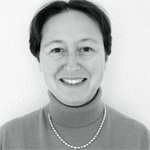Crystal gazing
Francesca Nessi-Tedaldi worked on collider physics in the UA2 experiment followed by calorimetry R&D for the Large Hadron Collider. For several years she has been working on the CMS experiment as a research scientist from ETH-Zürich.
 “The Compact Muon Solenoid detector, CMS, will help us to solve some of Nature’s outstanding puzzles, from how particles get their mass to why there is no antimatter around today. We will, of course, be searching for the hypothetical Higgs boson, but we will also be looking out for other exotic particles, expected and unexpected, at the LHC.
“The Compact Muon Solenoid detector, CMS, will help us to solve some of Nature’s outstanding puzzles, from how particles get their mass to why there is no antimatter around today. We will, of course, be searching for the hypothetical Higgs boson, but we will also be looking out for other exotic particles, expected and unexpected, at the LHC.
The CMS solenoid magnet will be the largest ever built. It will produce a magnetic field of 4 tesla, approximately 100 000 times stronger than the Earth’s field. A return yoke containing as much iron as the Eiffel Tower surrounds the solenoid to contain this field. Inside the huge magnet, CMS’s calorimeters will measure particle energies.
I work on the electromagnetic calorimeter, designed to detect photons, electrons and positrons. It is made out of 80 000 extremely dense lead tungstate crystals, heavier than iron. Astonishingly these crystals are transparent, even though they are almost entirely made of metal; 98% of their mass is lead and the even heavier tungsten. Their total weight equals that of about 24 adult elephants and it is no joke holding them up. A terrific engineering effort has gone into making a mechanical housing for the crystals, a honeycomb with walls 0.4 mm thin that doesn’t tilt, sag or bulge, even when full. This impressive structure will point the thousands of crystals towards the centre of the detector, like a fly’s eye.
Particle fluxes will be extremely high in the middle of the LHC detectors, putting considerable strain on the performance and useful lifetime of the inner layers. In this region, particles emerging from a collision are crowded together and really high recording quality is needed. It is also a particularly inaccessible region where we don’t want to have to do too much maintenance. Having contributed to extensive design studies and simulations of the calorimeter, in recent years I have mainly been involved in research into the resilience of our crystals, testing them in intense particle beams to make sure that they will do a good job from the beginning until the end of LHC operation.
The crystals originate in China and Russia and have interesting histories. In China, crystal production relies on well-controlled high temperature techniques that have centuries-old antecedents in the manufacture of the most exquisite porcelain for the aristocracies of Asia and Europe. In Russia, the production is a result of the International Science and Technology Center non-proliferation programme that has allowed this non–strategic application to become strategic to the success of CMS.”

